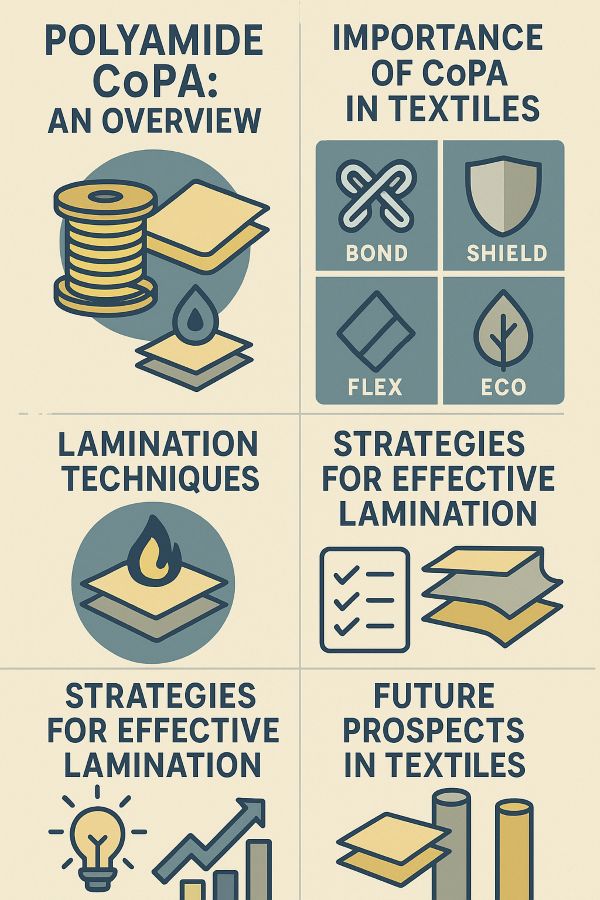
Polyamide CoPA: An Overview
Types of CoPA Adhesives
Importance of CoPA in Textiles
Lamination Techniques
Innovative Trends in CoPA
Strategies for Effective Lamination
Future Prospects in Textiles
Frequently Asked Questions (FAQ)
Polyamide CoPA plays a transformative role in textile lamination, offering high adhesion strength, excellent flexibility, and reliable thermal resistance. This adhesive class enables efficient production processes by reducing curing and setting times, making it an optimal solution for textile manufacturers. CoPA-based formulations cater to a wide range of applications—from general-purpose bonding to flexible laminates and environmentally responsible textiles—providing reliable performance under varying conditions.
Different types of CoPA adhesives are designed to serve specific textile needs. High-strength variants are ideal for structural bonding where durability is a priority. Flexible types suit applications such as performance wear, where elasticity and comfort are essential. Other variants emphasize resilience in challenging environments, including moisture or heat. Additionally, sustainable formulations derived from bio-based materials support eco-conscious manufacturing. These diverse types enable tailored performance, enhancing textile quality across categories such as fashion, upholstery, and technical fabrics.
Polyamide CoPA adhesives are vital in textile lamination due to their capacity to provide both strength and flexibility. Their thermal resistance helps maintain bond integrity under heat exposure, while their processing efficiency supports faster production. Whether applied to sportswear, functional fabrics, or protective textiles, CoPA adhesives contribute to longevity and quality. Eco-friendly CoPA options also support the growing industry trend toward sustainable manufacturing.
Lamination methods using CoPA adhesives include heat-activated bonding and pressure-assisted lamination. These techniques optimize adhesion without compromising fabric texture or breathability. Proper control of bonding parameters such as temperature and pressure ensures optimal integration of CoPA-based materials, particularly in applications requiring strength, stretchability, or environmental protection. Sustainable lamination techniques are increasingly being adopted to align with green production goals.
Recent trends in textile adhesives highlight the rise of CoPA systems engineered for advanced applications. Developments focus on enhancing wear resistance, wash durability, and environmental impact. Sustainable innovations include solvent-free and bio-based CoPA adhesives, while performance-driven trends target higher elasticity and faster processing times. These advancements reflect a broader industry push toward functionality, comfort, and responsible production.
To achieve optimal results with CoPA adhesives, it is essential to select the right formulation for the specific end-use. High-strength options are suited for heavy-duty textiles, flexible variants for stretch fabrics, and durable types for outdoor or industrial applications. Key lamination strategies include:
Surface preparation for optimal adhesion
Temperature calibration to avoid degradation
Pressure application to eliminate air pockets
Post-lamination curing for long-term stability
These methods ensure efficient processing and consistent performance across different textile categories.
As textile industries evolve, CoPA adhesives are expected to play a key role in the development of sustainable, multifunctional fabrics. Future directions include:
Integration of smart adhesive properties (e.g., heat-reactive or water-repellent)
Wider use of recyclable and biodegradable formulations
Enhanced compatibility with next-gen functional textiles
These prospects position CoPA adhesives as a foundational material for future-oriented textile innovation.
What is Polyamide CoPA and how is it used in textiles?
CoPA refers to a type of polyamide adhesive known for strong bonding, flexibility, and thermal resistance, widely used in textile lamination.
What types of CoPA adhesives are available?
Available types include high-strength, flexible, durable, and sustainable formulations tailored to specific textile applications.
How does CoPA benefit textile production?
It reduces processing time, enhances bond durability, and supports efficient high-quality lamination for various textile categories.
What lamination techniques are best for CoPA adhesives?
Heat-activated lamination and pressure bonding are effective methods that help achieve strong, uniform bonds in textile substrates.
Why is sustainability important in CoPA development?
Sustainable CoPA adhesives reduce environmental impact, support regulatory compliance, and align with consumer demand for green products.
Which industries benefit from CoPA-based adhesives?
Industries including fashion, sportswear, outdoor gear, and industrial textiles benefit from CoPA’s reliable and adaptable bonding capabilities.
What trends are shaping the future of textile lamination?
Trends include the shift toward eco-friendly adhesives, demand for faster processing, and development of smart, multifunctional bonding materials.
What future innovations are expected for CoPA in textiles?
Innovations may include smart adhesive features, expanded bio-based options, and improved performance in extreme conditions.